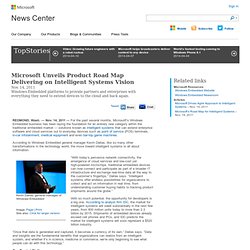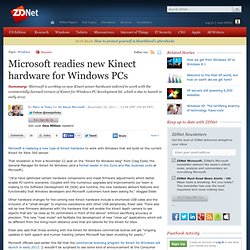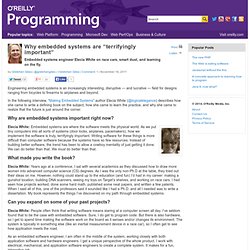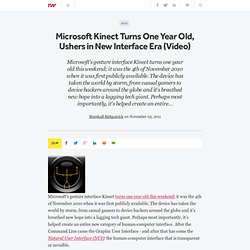

Hello, Stranger - Forbes.com. Kinect 2 capable of reading lips, gauging moods – Video Games Reviews, Cheats. The Kinect motion controller for the Xbox 360 has been a huge success for Microsoft, probably above and beyond what the company ever expected the peripheral to achieve in the short amount of time it has been available.

Unveils Product Road Map Delivering on Intelligent Systems Vision: Windows Embedded platforms to provide partners and enterprises with everything they need to extend devices to the cloud and back again. REDMOND, Wash. — Nov. 14, 2011 — For the past several months, Microsoft’s Windows Embedded business has been laying the foundation for an entirely new category within the traditional embedded market — solutions known as intelligent systems that can extend enterprise software and cloud services out to everyday devices such as point of service (POS) terminals, in-car infotainment, medical equipment and even bar-top game machines.

According to Windows Embedded general manager Kevin Dallas, like so many other transformations in the technology world, the move toward intelligent systems is all about information. Kevin Dallas, general manager of Windows Embedded. Microsoft readies new Kinect hardware for Windows PCs. Microsoft is readying a new type of Kinect hardware to work with Windows that will build on the current Kinect for Xbox 360 sensor.

That revelation is from a November 22 post on the "Kinect for Windows blog" from Craig Eisler, the General Manager for Kinect for Windows (and a former leader in the Zune and Mac business units at Microsoft). "(W)e have optimized certain hardware components and made firmware adjustments which better enable PC-centric scenarios. Coupled with the numerous upgrades and improvements our team is making to the Software Development Kit (SDK) and runtime, the new hardware delivers features and functionality that Windows developers and Microsoft customers have been asking for," blogged Eisler.
Kinect Gets a Hardware Upgrade for PC Use - PC News at IGN. It’s Official: Kinect for Windows is Coming Soon - Kinect for Windows Blog. To commemorate the one-year anniversary of Kinect and the Kinect Effect, I sent an email to my team earlier this week.

I’d like to quote for you what I said to them, “It all started with a revolutionary sensor and amazing software that turned voice and movement into magic. NUI Group - Natural User Interface Group. | About | Blog | Code | Community | Current | TV | Wiki NUI Group Go - Version 1.0 - Preview Build 0.0.1.5 Chrome 5.0 - Pass...

Firefox 1.9 - Pass... Firefox 2.0 - Pass... IE 6.0 - Fail... Browser Information mozilla : true version : 17.0 1) Community search engine: My Keywords 2) Media publishing systems: My Title + Youtube Link ID 3) URL path shortening service: My Title + Link. Kinect for Windows – Building the Future - Kinect for Windows Blog. Kinect 2 may be so accurate it can lip read. Microsoft’s next-generation Kinect device may be accurate enough to read your lips.

It has also been stated that future Xbox consoles will ship with Kinect 2 built in. Sources speaking to Eurogamer have claimed that the unannounced Kinect 2 will be able to read facial expressions and detect a variety of emotions through the user’s tone. Improved motion-sensing and voice-recognition technology are expected to be installed. The depth sensor in the current Kinect device was set to 30 frames per second upon the November 2010 launch, offering a 320×240 resolution limit.
The universal serial bus (USB) controller interface has the potential to run at 35 megabytes per second, but only utilizes around 15 to 16 megabytes per second. Eye Tracking Could be the Next Natural User Interface. You've seen those eye tracking heat maps that show where most people look first when they land on a web page - why not turn eye tracking technology like that into a replacement for your mouse or your finger on a touchscreen?
That's what a Danish startup called Senseye claims to be doing; they say they've got software for Android that uses the front-facing camera to track a user's eye movement and then uses that to control what happens on the phone's screen. They're not alone in working on doing that kind of work, either. Eye tracking could be a big new way that users interact with their devices. If the company can really pull this off, Senseye could join the ranks of Microsoft's Kinect, Surface and the touchscreen mobile devices in what people are calling the Natural User Interface (NUI).
A Swedish company called Tobii announced in-car eye tracking technology this week as well and these aren't isolated innovations. Let's assume it really works though. Microsoft Takes Kinect To The Business World. Having established a strong foothold in the home market, Kinect is ready to branch into the corporate world.

Microsoft plans to launch a commercial program for the peripheral early next year, giving businesses the tools to develop customized applications for their companies and industries. The pilot program already includes such familiar names as Toyota, book publisher Houghton Mifflin Harcourt and design firm Razorfish. All totaled, over 200 "marquis brand" companies in 25 countries have signed up for the program, David Dennis, Microsoft Product Manager, tells Gamasutra. Why embedded systems are "terrifyingly important" Engineering embedded systems is an increasingly interesting, disruptive — and lucrative — field for designs ranging from bicycles to firearms to airplanes and beyond.

How will we design products for the Internet of Things? As revolutionary as the mobile ecosystem is, it’s the interactions of more-intelligent connected devices with people outside the context of phones or computers that will drive more innovation, says Mark Rolston, the chief creative officer at Frog Design. Rolston, speaking at the Mobile Future Forward conference on Monday in Seattle described a future where devices become more contextually aware, thanks to embedded and connected sensors. Instead of thinking about the buttons on a phone or a laptop, manufacturers and designers need to think about what will happen when computers are embedded in everything and connected all the time. A New (NUI) Future for Humans & Computers: Microsoft Kinect Turns One Year Old (Video)
Microsoft's gesture interface Kinect turns one year old this weekend; it was the 4th of November 2010 when it was first publicly available.

The device has taken the world by storm, from casual gamers to device hackers around the globe and it's breathed new hope into a lagging tech giant. Perhaps most importantly, it's helped create an entire new category of human-computer interface. Why we need to take computers out of computing. Computers — the boxes that we consult in the form of tablets, mobile phones and desktops — are wonderful, but they take away from what it is to be human and to really connect with one another. So the challenge and opportunity that lies ahead is how to get the computers out of computing, said Mark Rolston, the chief creative officer at frog. Speaking at the GigaOM RoadMap conference in San Francisco, Rolston took the audience through a vision of omnipresent computing. “The room is the computer,” he said, as he described putting something like Apple’s Siri voice recognition system into an earpiece, and then being able to interact with a projector in a room to create a screen wherever the user needed one.
“Computing is decoupling. Most computers are composed machines, but if you can image a case where they are externalized resources in a room,” he said. Siri: Say hello to the coming “invisible interface” 1Executive Summary After solely using a Google Android phone for nearly two years, I recently added an Apple iPhone 4S to my stable of smartphones. Not because of the new dual-core A5 processor, advanced 8 megapixel camera sensor or retooled antenna design, however.
What sold me on Apple’s latest handset wasn’t hardware at all: It was the promise of an “invisible interface” through Siri, the iPhone’s personal assistant software. Siri is arguably the first working example of how everyday people will interact with connected devices in the near future. The ability to speak to our phones, televisions or homes and have them respond or take action is no longer a far-fetched concept. What Siri is Siri started out as a third-party application, launching on the iTunes App Store in 2010. That means the same question or command can be asked different ways, making the software far more versatile.